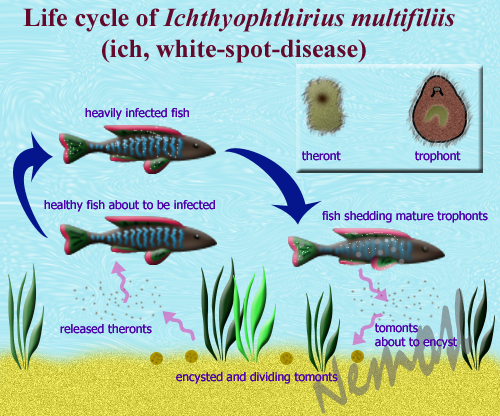Ichthyophthirius multifiliis
(ich, ick, fish white-spot disease)
- Ichthyophthirius multifiliis (described by Fouquet in 1876), a ciliate protozooan, causes white-spot or ich disease in fresh water fish. It has extremly low host specificity and can infect virtually any fresh water fish species. Unlike apicomplexan parasites, such as Plasmodium or Toxoplasma species I. multifiliis is not intracelllular parasite.
- The scientific name of the parasite is translated as "the fish louse with the many children" reflects its reproductive capacity.
- Concentration of the parasite in wild populations is low and massive mortalities from the infection are rare. In closed systems (ponds, fish farms, ornamental fish tanks) ich infection can lead to rapid fish death and devastating economic losses.
- The most common treatments for white-spot disease in fresh water fish are: raised temperature, raised NaCl concentration, formalin, and malachite green (banned in namy European countries). First two treatments are especially effective in combination. Fish species respond differently to different medications. It is very important to research effects of high temperature and chemicals on each fish species because some treatments can cause acute disstress and might kill fish quicker than the disease would. For example, scaleless fish cannot tolerate malachite green. Cold-water fish might suffer from high temperature.
- Recovered specimens can acquire various degrees of immunity against the parasite. Fish farms may choose to immunize cultured fish (theronts injected intraperitoneally into fish elicit protection). Vaccines against I. multifiliis are under development.
